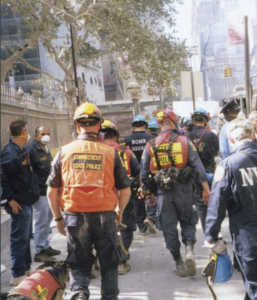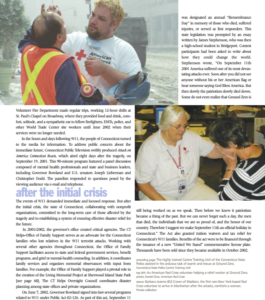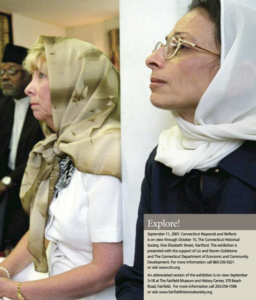by Anne Guernsey
(c) Connecticut Explored Inc. FALL 2011
Subscribe/Buy the Issue!
Interpreting contemporary events can be challenging, as historical perspective by definition takes a long time to develop. But acts of heroism often are immediately recognizable as just what they are: extraordinary actions that will remain remarkable even as time passes. In some cases a single individual’s heroism stands alone. But in the case of the terrorist attacks of September 11, 2001, it is the collective heroism of the firefighters, police officers, emergency workers, and civilians who put their lives on the line to help that we remember as one of the most remarkable, and memorable, aspects of that terrible episode in our nation’s history. Less stirring, but equally important, is the state’s response through programs supporting those affected by the tragedy.
 Because of our proximity to New York City, Connecticut was profoundly and intimately affected by 9/11. The state of Connecticut officially identified 153 people who died in the attack that day who had lived, worked, or had relatives in Connecticut. Scores of Connecticut residents were injured physically or psychologically. Others were affected financially by the loss of a job as a result of the attack. In the face of this tragedy, however, Connecticut came together as a community—to respond and reflect.
Because of our proximity to New York City, Connecticut was profoundly and intimately affected by 9/11. The state of Connecticut officially identified 153 people who died in the attack that day who had lived, worked, or had relatives in Connecticut. Scores of Connecticut residents were injured physically or psychologically. Others were affected financially by the loss of a job as a result of the attack. In the face of this tragedy, however, Connecticut came together as a community—to respond and reflect.
The Connecticut Historical Society created a multimedia, traveling exhibition in 2006 to mark the 5th anniversary of this monumental event. September 11, 2001: Connecticut Responds and Reflects, which received a Connecticut League of History Organizations Award of Merit and on which this article is based, provides a historical perspective on the tragedy and pays homage to Connecticans who lost their lives that day. Many of the quotations in this article are from the exhibition’s oral history project. In honor of the 10-year anniversary, the Connecticut Historical Society has extended the exhibition’s run; it will be on view at CHS in Hartford through October 15. A portion of the exhibition will also be on view at the Fairfield Museum and History Center from September 3 to 18, 2011.
The Initial Response
Former Governor John G. Rowland said of 9/11, “I’m sure everybody remembers what they were doing…and like everyone else, it was so confusing. I was having a meeting in the governor’s residence with about ten business men discussing, I believe it was the GHO (Greater Hartford Open golf tournament), and one of the troopers came in and pulled me aside and told me that my Washington office was on the phone…so, I went right to my emergency facility, which is located in the Armory.” The state of Connecticut went on to play a critical role as 9/11 unfolded and in the months and yearsto follow. In the days afterthe attack, Governor Rowland tried to contact families of all of the victims. Government officers, agencies, and relief organizations rose to the challenge to meet the immediate needs of those affected. Many organizations in Connecticut, such as the United Way of Connecticut and the American Red Cross, collaborated with the state and were on hand to help those who required services ranging from urgent financial assistance to mental-health support. Individual helpers made their mark, some traveling to New York City to pitch in at Ground Zero, others making monetary charitable contributions.
The state dispatched personnel, including teams from the Meridenbased Connecticut State Police Canine Training Unit, to New York City. On the day of the attack, the unit reported to lower Manhattan to help emergency management crews and New York law enforcement. Trooper Mark Linhard, a member of that unit, remembers, “Literally, within an hour and a half of us showing back up, we were in a convoy, lights and sirens going down to New York. We actually met a New York trooper at the border, and we got escorted all the way.” A total of 14 dog teams, including 5 with Fidelco-bred German shepherds, engaged in a difficult and dangerous search and rescue mission at Ground Zero that lasted 11 days. Linhard continues, “We were there…from dark to dark is what we call it… working in certain areas. … I remember standing next to another trooper and his dog starting to bite at the ground and dig at the ground. Once you were in there, it was just nonstop work and they would basically—you know, what we call the bucket brigade. There would just be a line of volunteers and firefighters and whatnot and they would just form a line and they would just start digging.”
Connecticut’s swift response was made possible by a 24-hour telephone referral system, Infoline, founded by the United Way of Connecticut in collaboration with the state in 1976. From September 11 to 15, 2001, the 2-1-1/Infoline center handled 2,500 calls directly related to 9/11 issues. People called for assistance, while others called to offer help. Governor Rowland asked Infoline to manage a separate line to assist the families of Connecticut’s 9/11 victims, 1-866-CTHELPS, which was accessible out of state. The United Way of Connecticut also acted as a fiscal agent for several funds, including the September 11th Fund, to be distributed to Connecticut families who lost loved ones and to persons who were injured or unemployed.
The American Red Cross provided multiple forms of assistance. The nonprofit organization offered mental health counseling and financial aid and also supervised blood collections. Connecticut’s Red Cross Chapters were extremely active in the relief effort.
In fact, the first non-New York Red Cross volunteer to arrive onsite after the attacks in Manhattan was Barbara Jeanne (BJ) Crown from Madison. Crown remembers her unsettling commute into the city that day: “I was on the Triborough Bridge. I had my Red Cross ID, so they let me onto the bridge. It was the only time in my life I’ve been…the only driver on the Triborough Bridge going into New York.” She goes onto say, “We worked straight through until, I guessit was about two o’clock the following, the morning of the 12th, trying to get organized, trying to make sure that if there was a shelter up some place that we had some mental health people there…There were people walking around with pictures. So many people lostrelatives and at that time, forthe first two orthree orfour days, nobody knew how many people were saved and how many people were in hospitals.” BJ’s own daughter and brother lived in New York, and she couldn’treach them immediately on the day of the attack. She explains what got her through: “It’s when you get involved in something like this that is so tragic and so big, it’s hard to think about anything else but what you’re doing. And there were so many questions, there wasso much to do, there was so much going on that I—I thought about my daughter, but I couldn’t—I couldn’t allow myself to—to break down about that.” Fortunately, BJ’s family was safe.
Teams of firefighters from towns throughout the state also traveled to the World Trade Center site in the weeks and months that followed to help. In early November 2001, for instance, members of the Suffield Volunteer Fire Department made regular trips, working 12-hour shifts at St. Paul’s Chapel on Broadway, where they provided food and drink, comfort,solitude, and a sympathetic earto fellow firefighters, EMTs, police, and other World Trade Center site workers until June 2002 when their services were no longer needed.
In the hours and daysfollowing 9/11, the people of Connecticut turned to the media for information. To address public concern about the immediate future, Connecticut Public Television swiftly produced Attack on America: Connecticut Reacts, which aired eight days after the tragedy, on September 19, 2001. This 90-minute program featured a panel discussion composed of mental health professionals and state and business leaders, including Governor Rowland and U.S. senators Joseph Lieberman and Christopher Dodd. The panelists responded to questions posed by the viewing audience via e-mail and telephone.
After the Initial Crises
The events of 9/11 demanded immediate and focused response. But after the initial crisis, the state of Connecticut, collaborating with nonprofit organizations, committed to the long-term care of those affected by the tragedy and to establishing a system of ensuring effective disaster relief for the future.
In 2001/2002, the governor’s office created critical agencies. The CT Helps-Office of Family Support serves as an advocate for the Connecticut families who lost relatives in the 9/11 terrorist attacks. Working with several other agencies throughout Connecticut, the Office of Family Support facilitates access to state and federal government services, benefit programs, and grief or mental-health counseling. In addition, it coordinates family services and organizes memorial observances with input from families. For example, the Office of Family Support played a pivotal role in the creation of the Living Memorial Project at Sherwood Island State Park [see page 48]. The CT Helps Oversight Council coordinates disaster planning among state offices and private organizations.
 On June 7, 2002, Governor Rowland signed into law several programs related to 9/11 under Public Act 02-126. As part of this act, September 11 was designated an annual “Remembrance Day” in memory of those who died, suffered injuries, or served as first responders. This state legislation was prompted by an essay written by James Stephenson, who was then a high-school student in Bridgeport. Contest participants had been asked to write about how they could change the world. Stephenson wrote, “On September 11th 2001 America suffered one of its most devastating attacks ever. Soon after you did not see anyone without his or her American flag or hearsomeone saying God Bless America. But then slowly the patriotism slowly died down. Some do not even realize that Ground Zero is still being worked on as we speak. Then before we knew it patriotism became a thing of the past. But we can never forget such a day, the men that died, the individuals that we are so proud of, and the honor of our country. Therefore Isuggest we make September 11th an official holiday in Connecticut.” The Act also granted tuition waivers and tax relief for Connecticut’s 9/11 families. Benefits of the act were to be financed through the issuance of a new “United We Stand” commemorative license plate. Thousands have been sold since they became available in October 2002.
On June 7, 2002, Governor Rowland signed into law several programs related to 9/11 under Public Act 02-126. As part of this act, September 11 was designated an annual “Remembrance Day” in memory of those who died, suffered injuries, or served as first responders. This state legislation was prompted by an essay written by James Stephenson, who was then a high-school student in Bridgeport. Contest participants had been asked to write about how they could change the world. Stephenson wrote, “On September 11th 2001 America suffered one of its most devastating attacks ever. Soon after you did not see anyone without his or her American flag or hearsomeone saying God Bless America. But then slowly the patriotism slowly died down. Some do not even realize that Ground Zero is still being worked on as we speak. Then before we knew it patriotism became a thing of the past. But we can never forget such a day, the men that died, the individuals that we are so proud of, and the honor of our country. Therefore Isuggest we make September 11th an official holiday in Connecticut.” The Act also granted tuition waivers and tax relief for Connecticut’s 9/11 families. Benefits of the act were to be financed through the issuance of a new “United We Stand” commemorative license plate. Thousands have been sold since they became available in October 2002.
Time to Reflect
As time passed, communities large and small came together for vigils and interfaith sessions. A 9/11 vigil at River front Plaza in Hartford was organized by River front Recapture on September 10, 2002. Connecticut citizens honored those who died in the attacks and pledged unity over discord. At dusk, candles were lit and the names of Connecticut’s victims were read aloud to then early 600 participants. The Islamic Association of Greater Hartford in Berlin hosted an interfaith service on September 11, 2002 in which Muslims and Christians showed solidarity in the pursuit of harmony and mutual respect.
Several people who lost family members on 9/11 used their personal loss to call attention to problematic issues surrounding the event. Groups such as the Skyscraper Safety Campaign™ and Voices of September 11th advocate for key issues such as architectural and policy reform. These groups also provide resources to families. The mission of Skyscraper Safety Campaign™ is, in part, to ensure the safety and security of all people who live, work, or fight fires in high-rise buildings. It was co-founded by Monica Gabrielle of West Haven, who lost her husband, Richard Peter Gabrielle Sr., who worked for Aon Corporation. The mission of Voices of September 11 is to provide information, support services, and annual events for 9/11 families, rescue workers and survivors, to commemorate the lives and stories of September 11, and to promote public policy reform on prevention, preparedness and response to terrorism, building bridges between international communities changed by terrorism.
Others turned to art for healing and remembrance. In 2002, artist Marilyn Thrall of Canton completed a memorial to Amy E. Toyen. Toyen, 24 and engaged to be married, had traveled from Boston to New York City for a work conference on September 11, 2001. The bronze, life-sized sculpture of Toyen as a child, seated on a pink granite bench, sits outside of the Avon Free Public Library, her home town library. Thrall says, “I wanted to interpret the beauty and innocence of life that was so part of Amy.” When working on the sculpture, Thrall met with the Toyen family to hear stories and to see pictures of Amy. Thrall said, “I think one of the interesting things was that my daughter is a year younger than Amy and so when I looked at the pictures and what she wore… it was like looking at my own children. So it was getting very personal… it could have been my daughter.”
Anesti Nova, a classical music composer from South Windsor, was moved to write a poignant piece called “The Valse Triste for 9/11.” Nova’s son, James, also a musician, had often traveled from Boston to Los Angeles on American Airlines Flight 11. But he was not on that flight that day when it crashed into the North Tower of the World Trade Center. The Nova family felt great relief that James was safe but also intense sadness for those who died. Nova expressed his deep emotions through his music, and his piece conveys the restorative notion that “we have to go on in life.”
Even seemingly ordinary materials such as steel or marble from Ground Zero serve as objects of contemplation because they are the few tangible remains of the Twin Towers. On 9/11, the Hanson family of Easton lost their son, daughter-in-law, and grand child. Peter, Sue Kim, and 2½ -year-old Christine (the youngest 9/11 victim) were on Flight 175 on their way to California, looking forward to a family vacation, when the plane crashed into the South Tower of the World Trade Center. In 2002 the City of New York gave the Hanson family a sculpture created by world-renowned artist Bryan Hunt using steel recovered from the World Trade Center site.
Judith Keane of Wethersfield has used relics given to her from Ground Zero as a teaching tool. Keane lost her husband, Richard, who was in New York on business. At his memorial service, Richard’s supervisor presented the Keane family with a box filled with debris from the World Trade Center site. Judith has since used the box and its contents to teach Connecticut school children about the tragic event.
In July 2001, flight attendant Dianne Bullis Snyder, who grew up in Wallingford and Madison, wrote by hand a list of “good things to do in life” and posted it on her refrigerator. When her sister asked whom this list was meant for, Dianne explained it was for “everybody.” After Snyder died on 9/11 in the crash of American Airlines Flight 11, her husband found a second page of the list under the refrigerator. It begins: “Live life to the fullest; no one knows what will happen tomorrow.” Elizabeth Bullis Weiss, Snyder’s sister and best friend, said, “I . . . thought that piece was just incredible… She would write something like that and the timing of it was just… and that it was found… I mean the fact that we saw the second page after she died, it was like she was giving us… more advice. Telling us to love each other…” The family has framed the lists, preserving them as reminders of Snyder’s life and spirit.
 Ten years later, 9/11 remains one of the key events in America’s history. The study of how Connecticut—the government, nonprofit organizations, regular citizens, and communities—responded to and reflected upon the tragedy will serve us well as we face future tragedies, natural or man-made.
Ten years later, 9/11 remains one of the key events in America’s history. The study of how Connecticut—the government, nonprofit organizations, regular citizens, and communities—responded to and reflected upon the tragedy will serve us well as we face future tragedies, natural or man-made.
